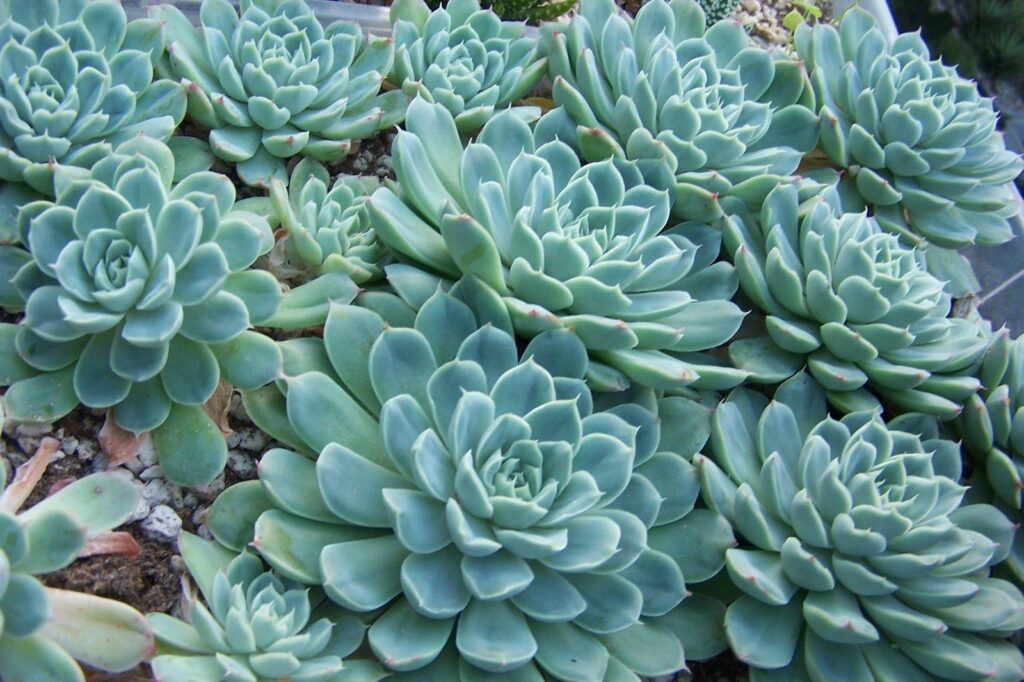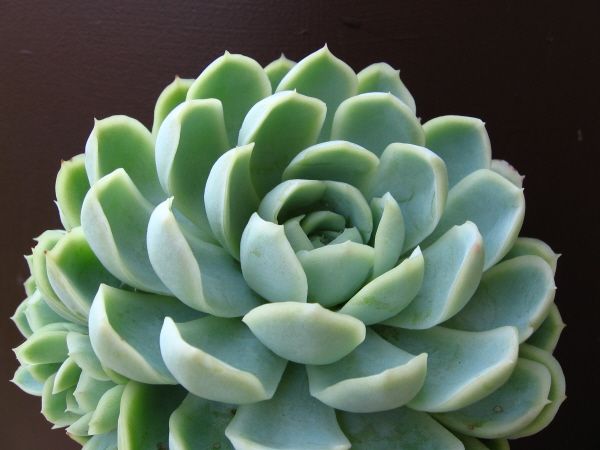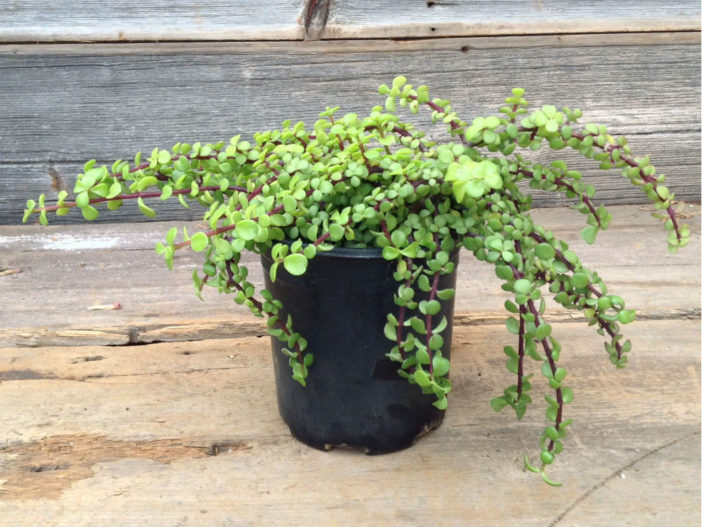Echeveria Elegans is an evergreen succulent that is closely related to Echeveria Albicans, Violet Queen, and Blue Lotus. This succulent is also known as hen and chicks since it propagates itself by offsets.
How to Identify Echeveria Elegans
This plant is often confused with Sempervivum because they both grow into rosettes and propagate by producing many tiny offsets. Fortunately, there are some key differences to help distinguish Echeveria Elegans from its look alike. The key features for identifying an Echeveria Elegans are:
- Its leaves have smooth edges; Sempervivum has spiny edges
- It blooms each year and survives; when Sempervivum blooms it dies
- When it blooms its flowers will grow on a tall stem
- Its flowers are bell-shaped and dangle
- It grows in a tight rosette
- Its leaves are spoon-shaped
- Its leaves are a pale silvery-green color
- Its leaves can turn shades of red with healthy stress
Where Does Echeveria Elegans Grow
Since this succulent requires heat and sunlight that is typical for most succulents, it is best to check which hardiness zone you live in before planting them in the ground. Since these plants are natives of Mexico, they will need to be kept in a climate that is similar to their homeland. USDA hardiness zones 9a to 11b are the only zones where these plants will survive outside during the winter months. If you do not live within these zones, it is recommended that you keep these plants in containers that are easy to bring indoors when it gets cold.
Uses of Echeveria Elegans

These plants are perfectly designed for growing as ground cover. They will thrive and fill up a landscape that is sandy, rocky, and gritty. They like a lot of sunlight, so they will do well in areas where other plants will shrivel from the heat.
They are also ideal for indoor windowsills and shelves. Echeveria Elegans will fill a pot with its offsets and these can be used to fill other pots and containers. Since they are so easy-going and hassle-free, they make great decorative plants for those who don’t have a lot of time to spare for gardening.
How to Grow Echeveria Elegans From Seed
These succulents can be germinated from seedlings in a few very simple steps. These steps are:
- Plant the seeds in a pot filled with potting soil designed for succulents
- Place the pots in a tray filled with water so the soil will absorb the water from the bottom
- Place the tray of pots in a warm area with indirect sunlight
- Note: the temperature should not be above 70 degrees Fahrenheit because the seeds will not germinate; 65 degrees Fahrenheit is the best temperature to germinate Echeveria Elegans seeds.
- Place a piece of plastic wrap over the pots to keep in air humidity
- Add water to the tray as needed
- It will take approximately three weeks to see any signs of successful germination from the planted seedlings. Evidence that the seeds are sprouting will be tiny leaves above the soil. As soon as these leaves are spotted, the plastic wrap should be removed.
- Also, it will be necessary to watch for fungus growth for the first two months. If any fungus begins growing on the tiny leaves, it should be treated with a fungicide.
Once the seedlings have grown into healthy plants, the following care must be taken:
- Move the new plants to a larger pot, if needed
- Note: Since potting soil holds in moisture and can cause root rot, Echeveria Elegans does not need a large pot that will hold a lot of soil.
- Feed the new plants with a diluted fertilizer during their growing season. This is usually springtime.
- Water the plants only when the soil is dry.
Echeveria Elegans Growing Conditions
For these plants to grow and thrive, they will need to be set in a place with full sun to partial shade, plenty of warm air, and well-draining soil.
When to Plant Echeveria Elegans
Spring and Summer are the best times to plant or repot an Echeveria Elegans. These are the times of the year when there will be the best amount of sunlight and heat.
How to Plant Echeveria Elegans
These succulents are very easy to plant. You can either start by planting seedlings or you can use offsets from a mother plant. The steps for planting seedlings have already been discussed above, so, let’s discuss how to plant an offset.
The steps for planting and growing an offset from a mother Echeveria Elegans plant are very simple and straightforward. The steps are:
- Separate the offset from its mother
- Fill a container two-thirds full of succulent potting mix
- Place the offset into the container
- Fill the remainder of the container with succulent potting mix
- Pat down the soil and check that the succulent is securely planted in the container
- Give the new plant a drink
- Set it in a warm sunny place
Echeveria Elegans Water Requirements

The water requirements of Echeveria Elegans are typical of most succulents: it needs very little. Since this plant is susceptible to root rot, it is best to use the soak and dry method when watering it. The steps for doing this are as follows:
- Fill a tray or a sink with a few inches of water.
- Set the plant container in the tray making sure that the water is not so deep that it will run over the top of the container. The point of watering in this way is so that the roots will soak up the water and the leaves will not get wet.
- Let the plant soak in the water for fifteen minutes. This will allow the root system to soak up water from the bottom of the container.
- Take the plant container out of the water.
- Place the plant container in a spot where the excess water can drain from the hole in the bottom.
- Repeat this only when the soil around the plant is dry.
If your Echeveria Elegans plant has been placed in an inground garden, then it will need to be watered in a slightly different manner. Here are some tips for watering this plant when it is in the ground.
- Only water it when the soil is dry
- Try to water only the soil around the plant
- Avoid watering the leaves of the plant
Echeveria Elegans Sun Requirements
Plants that are kept indoors will need to be placed in a window that gets at least six hours of direct sunlight each day. Plants that are kept outdoors will do well in full to partial sun. As with any plant, it is best to acclimatize it to the full sun so that it doesn’t dry out or get sunburnt.
Best Echeveria Elegans Fertilizer
Like most succulents, Echeveria Elegans doesn’t usually require fertilizer. However, fertilizer can be used at times to encourage healthy growth. It is very important that the fertilizer should be slow-release and diluted. It is also imperative that it is only used during the plant’s growing season; too much fertilizer can actually kill it.
An excellent option to use as a fertilizer for your Echeveria Elegans is HiThrive’s Succulent & Cactus Fertilizer. It is a dry and granular formula that will gently feed any cactus or succulent and is especially perfect for use on Echeveria plants.
Best Echeveria Elegans Companion Plantings
Sometimes it is nice to get your plant a companion. Companion plants complement one another and just make the look and feel of a garden complete. If you feel like your Echeveria Elegans needs a friend, try one of these lovely plants alongside it.
Portulacaria Afra

This plant is also known as Elephant Bush. It is a thickly stemmed succulent that grows into a bushy plant that is ideal for planting in a hanging basket. Not only is this a lovely plant to use in indoor and outdoor décor, it actually improves air quality. Portulacaria Afra is known to absorb high levels of carbon from the air surrounding it.
Pros:
- Water requirements are typical of succulents
- Comes in miniature and variegated varieties
- It is easy to propagate from stem cuttings
- It is known to clean air of carbon
- It is generally not toxic
- It is able to take more frequent watering than most other types of succulents
Cons:
- It is not cold hardy (grows outside in USDA hardiness zone 10)
- It can grow very large (up to 12 feet tall)
Echeveria ‘Afterglow’

This plant is a stunning beauty. It grows in a loose rosette with leaves that are tinted blue and tipped with bright pink. Plus, it blooms bright orange flowers in the summertime. Afterglow is an absolute must-have for all succulent gardens.
Pros:
- Water requirements are typical of succulents
- It is easy to propagate from stem cuttings, leaves, and offsets
- It attracts hummingbirds
- It is a small plant that only grows up to 24 inches tall and 24 inches wide
- It is not toxic to humans and animals
- It is deer resistant
Cons:
- It is not cold hardy (grows outside in USDA hardiness zone 9a)
- It is susceptible to root rot
- It is susceptible to attacks from mealybugs, vine weevils, and aphids
Echeveria Runyonii ‘Topsy Turvy’

If you’re looking for a monochrome companion for your Echeveria Elegans, this gray-green succulent is perfect. It also grows in a rosette but with long, curly leaves that seem to twirl next to each other. It is a fast-growing option that also produces orange and yellow flowers during the months of Autumn.
Pros:
- Water requirements are typical of succulents
- It is a very tiny plant that only grows up to 6 inches tall and 8 inches wide
- It is easy to propagate by offsets
- It is not toxic to humans and animals
- It grows well in difficult soil
- It is deer resistant
Cons:
- It is very susceptible to overwatering
- It does not grow well indoors
- It is not cold hardy (grows outside in USDA hardiness zone 9a)
Echeveria Elegans Diseases and Common Problems
These succulents are quite hardy and nearly free of disease and pests; however, there are some things that you will need to watch out for:
- Aphids
- Mealybugs
- Vine Weevils
- Cold weather for long periods of time
Echeveria Elegans Treatments and Maintenance
If your Echeveria Elegans plant gets an infestation of any pests, there are a few things you can do to treat it:
- Spray it with water so that that it disturbs the pests and gets them off the plant
- Apply an insecticidal soil drench
Note: Do not clean the leaves of this plant with neem oil or apply an insecticide to them; the leaves have a waxy coating that protects them from sun damage
Before you plant an Echeveria Elegans in the ground, it is best to check that you live in the proper climate zone so that it will survive the winter outdoors. This plant can handle temperatures between 20 and 50 degrees Fahrenheit, but they still prefer warm, sunny climates that are most commonly found in USDA Hardiness Zones 9a to 11b. If you live outside of these zones, it is recommended that you plant Echeveria Elegans in a container that can be transported indoors during cold weather.
Echeveria Elegans Repotting Instructions
When it comes to repotting an Echeveria Elegans, it is a matter of following a few simple steps. These are:
- Remove the plant from where it is currently planted
- Gently dust off any excess soil from the plant’s roots
- Remove any damaged roots from the plant
- Fill a container two-thirds full with succulent potting mix
- Place the plant onto the potting mix
- Fill the remainder of the container with succulent potting mix
- Check that the plant is securely in the soil
- Water the soil
- Place the plant in an area that is warm and sunny
Where to Buy Echeveria Elegans Seeds Online
Most echeveria plants are bought when they are grown. They are so easy to propagate by offsets that many gardeners don’t even bother with seeds. However, if growing a plant from a seedling is what you want to do, then look at Rarexoticseeds for a seed mix.
Where to Buy Echeveria Elegans Plants Online
This type of succulent is easy to find in many online shops. It is specially promoted at the following stores:
FAQs
Question: Should I Cut the Flowers Off My Echeveria Elegans?
Answer: Yes, the blooms should be removed once the plant has finished blooming and they are beginning to wither.
Question: What Can I Do with Echeveria Flowers?
Answer: Since the flowers of the echeveria plant produce seeds, you can keep the flowers to harvest the seeds in order to grow a plant from seedlings. Simply take the flower and place it in a paper sack so that the tiny seeds are captured. Then, begin planting them in potting soil.
Question: How Long Do Echeveria Flowers Last?
Answer: The flowers of an echeveria plant will typically last around two weeks before they begin to wither.
Concluding Thoughts
Echeveria Elegans is a gift to all, especially to those who don’t have a green thumb. These little plants are so hassle-free that anyone can grow one without stressing. Plus, they are beautiful. So, get yourself a tiny piece of nature for any part of your living quarters.
More plant-related guides here:
- Echeveria Lilacina (Ghost Echeveria): Easy Tips To Grow and Care 101
- Aloe Polyphylla (Spiral Aloe): How To Grow A Rare Spiral Succulent
- Callisia Repens (Turtle Vine): The Best Way To Grow Your Succulents At Home
- Lophocereus Marginatus (Mexican Fence Post Cactus) - January 10, 2022
- Best Cactus Fertilizer Guide - January 9, 2022
- Selenicereus Grandiflorus (Queen of the Night) - January 3, 2022


